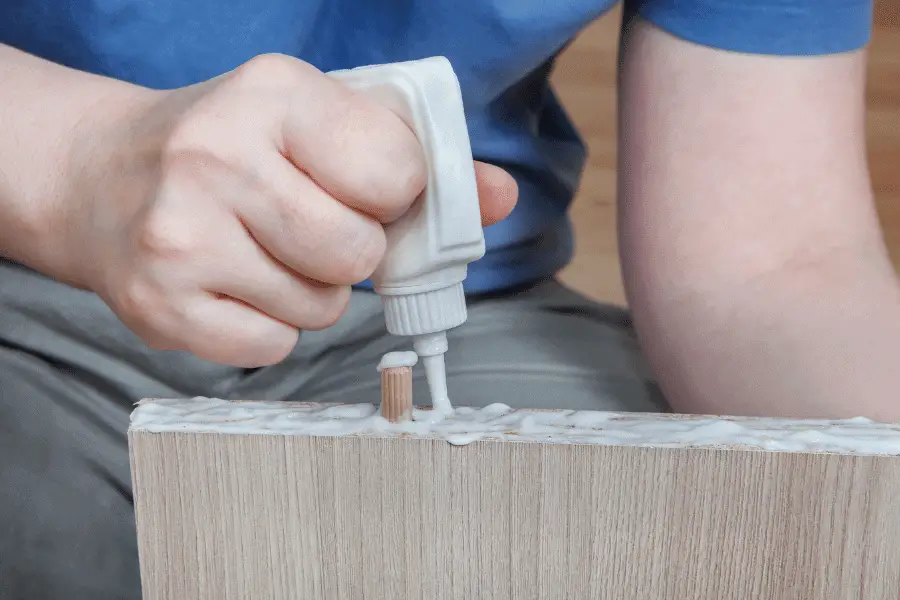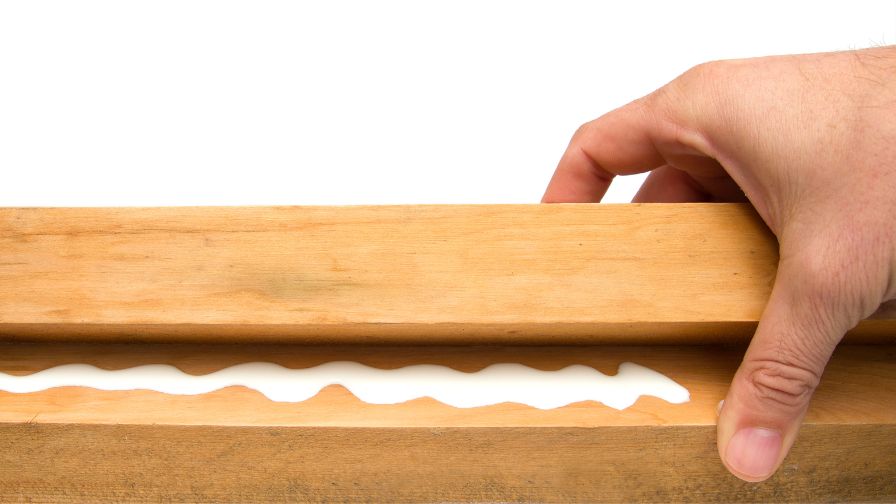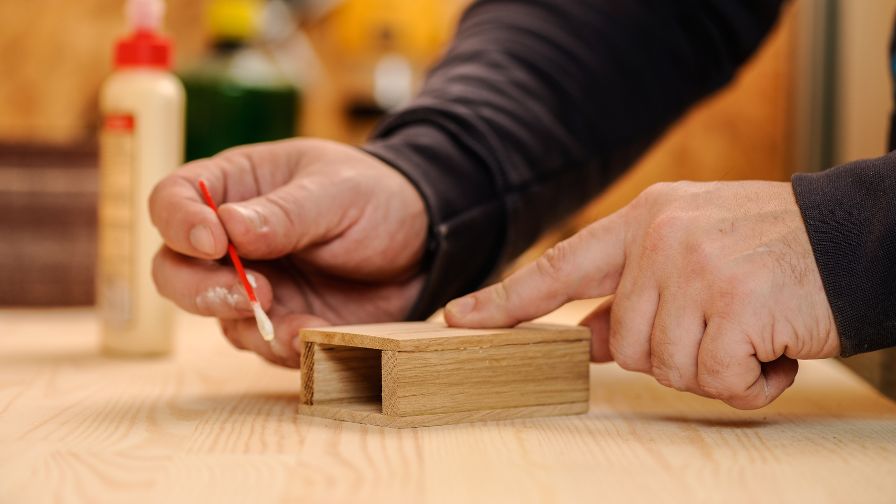
Wood glue is the most common way to join pieces of wood together.
If you are here today, it’s obvious that you have some DIY woodwork to be done, and now you want to know if using wood glue would be the right option. Well, for starters, when it comes to glue for such work, you will never run short of options as there’s a huge variety of them out there. But if you are working on creating a wooden table, a chair, or any other wooden item, you should choose wood glue.
How Long Does Wood Glue Take To Dry? It typically takes around 24 hours for wood glue to fully dry. Wood glue will be partially dry within an hour and will have a lot of strength but it is best to allow it time to fully cure. However, this will depend on the type of wood glue you’re using as well as the temperature and humidity in your workspace.
Even when it comes to wood glue, you have five different options, and each option comes with its strength and limitations. In simpler words, when using glue for your woodwork, you should first choose the wood glue type wisely and then start working on the project.
Well, if you want answers to it, this is the right place for you. Today we are going to answer all of your major concerns regarding wood glue so that you can create your masterpiece in a carefree way.
How Long Does Wood Glue Take To Dry?
It typically takes around 24 hours for wood glue to fully dry. Wood glue will be partially dry within an hour and will have a lot of strength but it is best to allow it time to fully cure. However, this will depend on the type of wood glue you’re using as well as the temperature and humidity in your workspace.
As per the rule of thumb, you should give 24 hours to all kinds of glue-ups to dry properly. Yes, you have to be a little patient here, but this is the safest time limit to wait for, or else you’ll be putting your chair or table at risk if you remove the clamps early.
What Is The Fastest Drying Wood Glue?
The fastest drying wood glue is a type of cyanoacrylate glue. These glues work by bonding to the wood fibers and curing rapidly. They are typically used for small repairs or for holding together pieces that will be clamped until the glue dries.
Cyanoacrylate glues are available in different formulations, so it is important to choose one that is specifically designed for wood. These glues come in both liquid and gel form, and the type you choose will depend on the project you are working on.
For general woodworking projects, a liquid cyanoacrylate glue is a good choice.
Does Wood Glue Dry Fast?
Each type of wood glue has a different drying period, but overall, yes, wood glue does dry fast only if you don’t apply it in thick blobs. Also, it depends on the type and quality of wood glue that you are buying.
For example, most woodworkers out there use Titebond as it’s considered a premium wood glue brand that comes with a drying period of around half an hour to one hour.
For a safer side, you should let the clamps stay there for 24 hours, but if you are using Titebond glue, there’s no need to wait for that long. What you need to know about wood glue is that it’s a water-based adhesive, it will dry faster in warmer areas with warmer air than colder air.
It also depends on the material that you are using the glue on. If it’s some fabric or some paper, the water will evaporate faster, and the glue will dry quicker.
How Long Does Gorilla Wood Glue Take To Dry?
Gorilla wood glue takes about 24 hours to dry completely. However, it is best to wait at least 48 hours before subjecting the glued area to any stress. This will give the glue time to fully cure and become stronger.
Gorilla wood glue is a strong and reliable adhesive that can be used for a variety of projects. It is important to know how long it takes to dry so that you can plan accordingly. With a little bit of patience, you will have a strong and lasting bond.
Does Wood Glue Need Air To Dry?
Yes, wood glue needs airflow to dry properly. Without airflow, the glue will not dry evenly and could result in a weak bond.
To ensure proper drying, apply wood glue to one surface only and clamp the two pieces together. Clamping the pieces together will help to provide even pressure and prevent warping. Then, allow the glued area to air dry for at least 24 hours before using or sanding.
You can speed up the drying process by using a fan or hair dryer on the low setting. Just be sure not to use too much heat, as this could cause the glue to soften and lose its bond.

How Strong Is Wood Glue?
Wood glue strength ranges from 3,000 to 12,000 PSI. Typically your wood with break and split before the wood glue will break because it is so strong.
Quality manufacturers claim that their wood glue will help you create a stronger joint than the wood itself. Also, it depends on the application. If the application is a little thicker, the joint will be stronger.
You need to pay attention to the clamp because if you clamp it tightly, you won’t have to worry about anything after the glue dries. However, in most cases, woodworkers say that the joint with wood glue is stronger than the wood itself, which is enough explanation for you to try it once at least.
The wood glue’s strength depends on the type you are buying and the company you are buying the glue from.
What Is Stronger Wood Glue Or Epoxy?
Even though both wood glue and epoxy are strong adhesives, epoxy is stronger. Epoxy is a two-part adhesive that comes in a syringe. It’s ideal for bonding metal, glass, and ceramic.
How Can I Get Wood Glue To Dry Faster?
You can get wood glue to dry faster by using a hairdryer or by using a clothes iron. Just be careful not to overheat the glue and damage the wood. You can also try putting the glued area in direct sunlight. The heat will help speed up the drying process.
Another way to get wood glue to dry faster is to add a little bit of water to the glue before you apply it to the wood. This will help to speed up the drying process.
You can also try using a heat lamp to speed up the drying process. Just be careful not to overheat the glue and damage the wood.
If you are in a hurry, you can try using a quick-drying wood glue. These types of glues are designed to dry quickly so that you can get on with your project.
Is Wood Glue Stronger Than Screws?
You might be surprised to learn that wood glue is actually stronger than screws. This is because screws tend to pull out of the wood over time, while glue creates a stronger bond. Of course, this isn’t to say that you should never use screws again – they’re still necessary for certain projects. But if you’re looking for a way to make your woodwork stronger, glue is the way to go.
What Are The Disadvantages Of Wood Glue?
Wood glue has a few disadvantages, the most notable being that it is not as strong as some other types of glue. This means that it is not ideal for use in applications where a very strong bond is required. Additionally, wood glue can be somewhat difficult to work with because it tends to be very sticky. This can make it hard to apply and can also lead to a mess if it is not used carefully. Finally, wood glue is not always as durable as other types of glue, which means that it may not hold up over time in some applications. Despite these drawbacks, wood glue is still a very popular choice for many woodworking projects because it is easy to use and relatively inexpensive.

